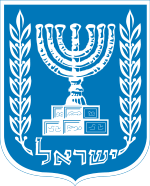- Gabriel and Maxim Shamir
-
Gabriel Shamir (b. Guttel Sheftelowitz, Libau, Latvia, 1909; d. Israel, 1992) and Maxim Shamir (b. Maxim Sheftelowitz, Libau, Latvia, 1910; d. Israel, 1990), were Israeli graphic designers.
Both of the Shamir brothers studied graphics and design at the Kunstgewerbeschule of Charlottenburg in Berlin, Germany—Gabriel in 1926-30 and Maxim in 1928-33. 1930-31, Gabriel worked for advertising agency Lintas in Berlin and, 1931-33, for advertising agency Gumaelius in Stockholm. In 1934, they opened a graphic-design studio in Riga, Latvia, but the next year immigrated to Eretz Israel (or Land of Israel, as the pre-state in Palestine was known to the Jews). The brothers arrived during the fifth wave of immigration and very soon set up the Shamir Brothers Studio at Sderot Rothschild 84 in Tel Aviv. The time was a lively and somewhat prosperous period, when the port of Tel Aviv was built (1936), the Levant Fairs were inaugurated (1932, 1934, 1936), and the first Maccabiah Games were held (1932, 1935). These and other advents created a propitious climate for those like the trained and experienced Shamirs who could create effective propaganda and advertising material, such as posters. These early years in Eretz Israel of the development of promotion and persuasion by professionals lead to the 1935 establishment of the Department of Graphics at the Bezalel Academy of Art and Design and The Society of Hebrew Graphic Artists in Eretz Israel of which the Shamirs were two of the cofounders.
Because there were few Hebrew typefaces available, the Shamirs and others improvised hand-painted Hebrew letters, often into transliterated words from European languages and English. Eventually, a number of faces became available even though some were Europeanized into Hebrew letterforms that called on sans-serif fonts such as 1925 Universal by Herbert Bayer (re-formed by Jan Tischold in 1926) and 1928 Futura by Paul Renner. Whereas Franz Kraus, the Austrian graphic designer who arrived in Eretz Israel a year before the Shamirs, adhered to a uniform type style, the brothers sought typography that they felt expressed the subject matter.
The story of the Shamir brothers, whose images of people were infused with an optimistic, even joyous, attitude in numerous examples, is also the story of Israel's formative years. They were empathetic partners with those enthusiastic about the future of the formation of an official State of Israel, and the Shamirs assisted the quest by visually fostering the citizens' sense of a national unity. The brothers undertook to formalize and actualize the visual symbols of Israeli sovereignty and independence. Hence, they designed the state's emblems, medals, stamps, and currency notes, including the 1949 Israeli State Coat of Arms (an image of a menorah and olive branches). In addition, they advertised cigarettes and other consumer goods, as well as designed stamps for countries in Africa, Asia, and South America. Their posters, other advertisements, and logos from 1935 to the close of their studio in 1974—rendered for the lottery, marketing fairs, land settlement, support of the army, food rationing, anti-black-market drives, and other nationalistic efforts—express a hyped Communist attitude, but not extreme or dour as in the propaganda of Bolshevik Russia. Even so, most Shamir work promoting nationalistic causes possessed a strong Israeliness and an heroic dimension which are absent in the country today.
The Shamir brothers are two of Israel's most-prominent graphic designers; the others include Franz Kraus (1905–98), Dan Reisinger (b. 1934) and David Tartakover (b. 1944).
Major Exhibitions
- Commercial Art of Palestine 1936 – Levant Fair, Tel Aviv
- Shamir Brothers 1940 - Studio Shamir, Tel Aviv, Curators: Gabriel and Maxim Shamir
- To Live with the Dream 1989 – Museum Tel Aviv of Art, Curator: Batia Donner
- Product of Palestine (1923-1948) 1997 – Israel Museum, Jerusalem, Curator: Matti Meir
- Vision and Propaganda 1998 – Israel Museum, Jerusalem, Curator: Batia Donner
- Hebrew Graphics-Shamir Brothers Studio 1999 - Tel Aviv Museum of Art, Curator: Batia Donner
- Israeli Posters c.2000 – Zionist Central Archive, Jerusalem, Curator: Lifsha Ben-Shah
- Landmarks-Posters from Zionism 2000 Collection 2008 - Zionism 2000, Beit Yehoshua, Curator: Inbal Amit
- The Right to Scream – May 1 Posters 2003 – Farkash Gallery, Jaffa, Curator: Aharon Farkash
- A Dialogue between Shamir Brother and Contemporary Artists 2004 – WIZO Design College, Haifa, Curators: Anat Gateniu and students
- The New Hebrew -100 Years of Israeli Art, 2005 – Martin Gropius House, Berlin, Curators: Doreet LeVitte, Yigal Zalmona
- The Histadrut – All the Way with the State of Israel 2006 –amalnet.k12.il, Curators: Alexandra Tomarinson, Matti Kanterovich
- Bank Notes and Coins - permanent exhibit 2009 – Bank of Israel, Jerusalem, Curator: Dr. Rachel Barkai
- Israel Art – permanent exhibit 2010 – Israel Museum, Jerusalem, Curators: Amitai Mendelshon, Yigal Zalmona
- Hebrew Woman, Join the Army! 2010 – Eretz Israel Museum, Tel Aviv, Curator: Batia Donner
- 90 Years of Vision - Keren HaYesod Posters 2010 – Ben- Gurion Airport, Lod, Curator: David Tartakover
- The Emblem of the State in Caricature 2011 – Israel Museum of Cartoons and Comics, Holon, Curators: Daniella Gardosh Santo, Yoram E. Shamir
- 60 Anniversary of Binyanei HaUma 2011 – International Convention Center, Jerusalem, Curator: Monica Lavi
- JNF Posters - from the Beginning to the Present 2011 – eyarok.org.il, Curator: Meir Sadan
References
- Shamir, Maxim and Gabriel (1969). The Story of Israel in Stamps, New York: Sabra Books; Funk & Wagnalls.
- Shamir, Maxim and Gabriel (1969 and 1972). Die Geschichte Israels in Briefmarken, New York: Sabra Books; Tel Aviv: Hakesher.
- Exhibition catalog, Donner, Batia, et al. (1999). Shamir: Hebrew Graphics, Shamir Brothers Studio, Tel Aviv: Tel Aviv Museum of Art.
Categories:- Latvian emigrants to Israel
- Israeli designers
- Graphic designers
- Israeli stamp designers
- Sibling duos
Wikimedia Foundation. 2010.


